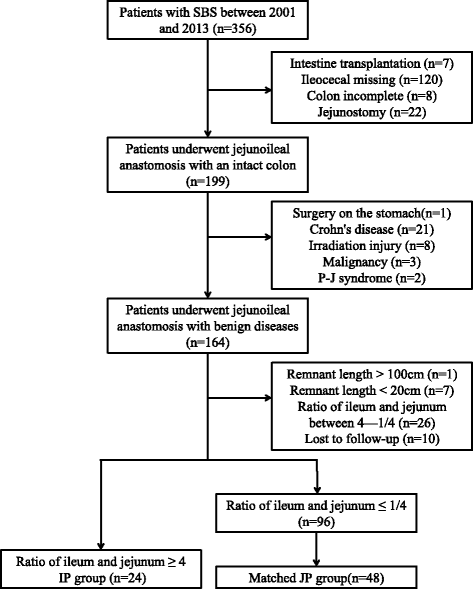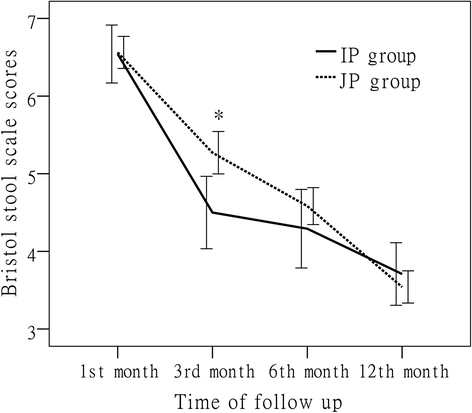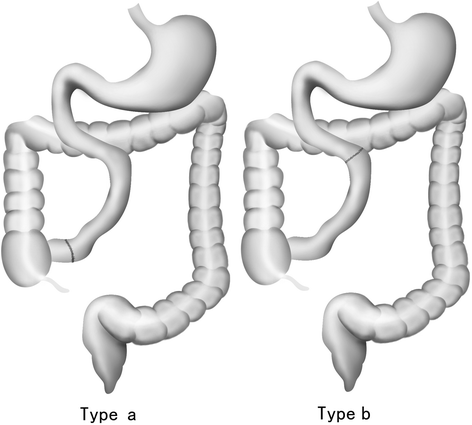A potential anatomic subtype of short bowel syndrome: a matched case-control study
- PMID: 26822147
- PMCID: PMC4731974
- DOI: 10.1186/s12876-016-0425-4
A potential anatomic subtype of short bowel syndrome: a matched case-control study
Abstract
Background: Fundamental researches suggest that ileum presents greater adaptive potential than the jejunum. However, few studies estimate the association between ileum and adaptive potential in human. To discover the association, we conducted this matched case-control study.
Methods: A 1:2 pair-matched, case-control study was conducted from January 1, 2001 to January 1, 2015 in Intestinal Rehabilition and Transplant Center. The case group was ileum predominated (IP) group and the control group was jejunum predominated (JP) group. Demographic data, medical history and progression of each patient were collected.
Results: There were 24 IP cases and 48 JP controls in this study. The cumulative probabilities of parenteral nutrition (PN) weaning in IP group were higher than that in JP group. The Bristol stool scale scores of IP group were lower than that of JP group at third month. The Cox proportional hazards regression model confirmed that IP had a higher odds of PN weaning (OR = 2.69; 95 % CI: 1.27, 5.70, p = 0.01) as compared with JP group. The conditional logistic regression with 1:2 matching also confirmed IP group had a higher odds (OR = 4.84; 95 % CI: 2.02, 11.56, p <0.01).
Conclusions: Our results indicated that ileum presents greater adaptive potential than the jejunum in nutrition and fluid absorption. And a potential anatomic subtype of short bowel syndrome was proposed. Further research need to be conducted to more fully understand the adaptive potential of ileum besides nutrition and fluid absorption.
Figures





Similar articles
-
[A study of the difference in intestinal adaptation between the residual jejunum and the ileum in rats with short bowel syndrome].Fukuoka Igaku Zasshi. 2004 Jul;95(7):167-72. Fukuoka Igaku Zasshi. 2004. PMID: 15506494 Japanese.
-
Long-term survival and parenteral nutrition dependence in adult patients with the short bowel syndrome.Gastroenterology. 1999 Nov;117(5):1043-50. doi: 10.1016/s0016-5085(99)70388-4. Gastroenterology. 1999. PMID: 10535866
-
Effect of sex and sex hormones on structural intestinal adaptation after massive small bowel resection in rats.J Pediatr Surg. 2005 Mar;40(3):489-95. doi: 10.1016/j.jpedsurg.2004.11.039. J Pediatr Surg. 2005. PMID: 15793723
-
Strategies for parenteral nutrition weaning in adult patients with short bowel syndrome.J Clin Gastroenterol. 2006 May-Jun;40 Suppl 2:S94-8. doi: 10.1097/01.mcg.0000212679.14172.33. J Clin Gastroenterol. 2006. PMID: 16770168 Review.
-
Etiology and initial management of short bowel syndrome.Gastroenterology. 2006 Feb;130(2 Suppl 1):S5-S15. doi: 10.1053/j.gastro.2005.07.063. Gastroenterology. 2006. PMID: 16473072 Review. No abstract available.
Cited by
-
Generation of Porcine Ileum Through Spring-Mediated Mechanical Distraction.J Surg Res. 2022 Dec;280:371-378. doi: 10.1016/j.jss.2022.07.043. Epub 2022 Aug 26. J Surg Res. 2022. PMID: 36037614 Free PMC article.
-
Surgeon's perspective on short bowel syndrome: Where are we?World J Transplant. 2018 Oct 22;8(6):198-202. doi: 10.5500/wjt.v8.i6.198. World J Transplant. 2018. PMID: 30370230 Free PMC article.
-
An Assessment of the Nutritional Status in Patients with Inflammatory Bowel Disease-A Matched-Pair Case-Control Study.Nutrients. 2025 Apr 17;17(8):1369. doi: 10.3390/nu17081369. Nutrients. 2025. PMID: 40284232 Free PMC article.
References
Publication types
MeSH terms
LinkOut - more resources
Full Text Sources
Other Literature Sources

